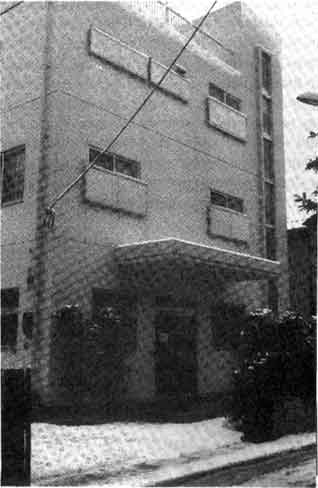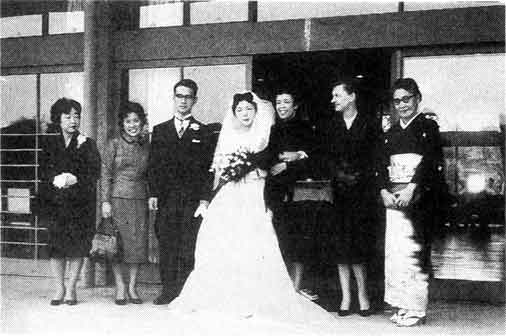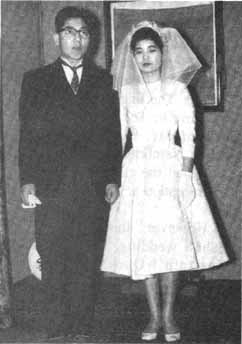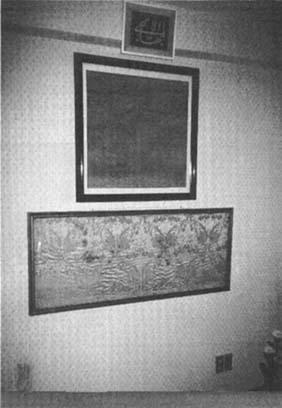
|
Unfurling the Divine Flag in Tokyo:
An Early Bahá'í History
by Barbara R. Sims
 |
chapter 10 | start page | single page | chapter 12 |  |
Chapter 11
11. The National Hazíratu'l-Quds
The National Hazíratu'l-Quds, or as it is more commonly known, the Tokyo Bahá'í Center, is located in Shinjuku Ward in the west of Tokyo in a neighborhood known as Nukebenten situated on a hill. Buddhist temples and a Shinto shrine are nearby. The shrine is dedicated to Benten, the goddess of art, music, literature and eloquence, the only goddess among the Seven Gods of Good Fortune.The Guardian had given as one of the many goals of the Ten Year Crusade the purchase of a National Hazíratu'l-Quds for seventeen of the major cities of the world. Tokyo was one of them. The Guardian also indicated that he would assist in the purchase of these buildings.
In 1954 a letter written on behalf of the Guardian instructed the Tokyo Local Spiritual Assembly to purchase a Hazíratu'l-Quds to be used for Bahá'í activities. The letter said it was urgent and should be accomplished that year. Tokyo Bahá'ís knew it was necessary, as sometimes meetings with seekers had to be conducted in coffee shops.
The Local Spiritual Assembly appointed a committee to search for a place that would suit the needs and requirements, one of which was that it had to be inexpensive. The Guardian, knowing of the situation in Japan, had written that the Center could be modest. The committee was not able to find a suitable place.
When the Iranian pioneer, Mr. Y.A. Rafaat, came to Tokyo in 1953 he bought a house. Actually he had come a year earlier to look over the prospects but returned to Iran to settle his affairs before pioneering.
After Mr. Rafaat bought the house, all meetings, Feasts and Holy Days in Tokyo were held in it with Mr. Rafaat as the welcoming host. So it was, in effect, a Bahá'í Center already. It was Agnes Alexander who, in 1954, wrote to the Tokyo Local Spiritual Assembly from Kyoto that she thought Mr. Rafaat's house would be a good Bahá'í Center. Mr. Rafaat agreed to sell his house to the Tokyo Local Spiritual Assembly which immediately put out a call for funds, and, according to the Tokyo Local Spiritual Assembly records, many people responded with donations. The transaction was concluded in December 1954. The Guardian cabled that he was "delighted." A large donation had come from the Guardian himself; about half of the cost. Because of this, the Tokyo Bahá'ís always felt that the small house was very precious. And when it was torn down and a new Center built on the same land the feeling continued; the land that was bought partially by the Guardian was still in use by the Bahá'ís.
In 1954 the Guardian sent a very precious gift to Tokyo, hand-carried by Mr. Hiroyasu Takano who was returning from his pilgrimage. A letter from the Guardian stated that it was a brocade which had "rested immediately over the remains of Bahá'u'lláh in His glorious Shrine," and that the Guardian hoped it would be a source
of inspiration to the friends to redouble their efforts in the teaching field. The letter also said that the brocade should ultimately be displayed in the National Hazíratu'l-Quds. That precious brocade, displayed in the prayer room of the National Hazíratu'l-Quds, has been a source of inspiration for the friends for many years, as the Guardian hoped.
In 1956 the Guardian sent to the Tokyo Local Spiritual Assembly two more precious cloths. One was a light green brocade, from the Shrine of 'Abdu'l-Bahá. It is also displayed in the prayer room. The other was a hand-embroidered long white cloth from the Shrine of the Báb. That cloth is kept in the National Bahá'í Archives.
In September 1955, after the Nikko Conference, the Hazíratu'l-Quds was dedicated with about 40 people attending. Among those was Miss Charlotte Linfoot of the National Spiritual Assembly of the United States. During the ceremony, candles donated by Hand of the Cause Amelia E. Collins which had been lit at the Shrine of Bahá'u'lláh were lit briefly.
Lt. and Mrs. Lawrence Hamilton, attached to the U.S. Air Force, lived in the Center from April 1955 to March 1957, when they left Japan. Lt. Hamilton did much to improve the Center by having walls put around the land, rewiring, remodeling the kitchen and adding a room.
Mr. Rafaat returned to Japan in April 1957 and stayed at the Center until March 1959, during which time he was busy as secretary of the new National Spiritual Assembly of North East Asia.
Pioneer Mr. John McHenry III stayed at the Center for about two months, April and May 1959.
Miss Agnes Alexander stayed at the Center from May 1959 until July. She said she loved to say her prayers before the sacred cloth sent to the Hazíratu'l-Quds by the Guardian.
Dr. and Mrs. David Earl moved into the Center in July 1959 and stayed until March 1963 when they left Japan.
Dr. and Mrs. Yasuyuki Hosoda lived there from March 1963 until June 1964.
Mr. and Mrs. Hiroshi Yamazaki lived in the Center from July 1964 until February 1967.
Miss Ruth Walbridge, a nurse by profession, stayed at the Center for a time with Mr. and Mrs. Yamazaki. At the request of Dr. Muhajir, she had come from her pioneering post in the Philippines to help take care of Hand of the Cause Miss Alexander, who was hospitalized in Tokyo with a broken hip. Miss Walbridge
accompanied Miss Alexander to Hawaii when
she left Japan in the summer of 1967.
Dr. and Mrs. Toshio Suzuki lived in the Center for three years from March 1967 to December 1970.
In the years following, sometimes the Center had no custodian, in which case the Tokyo Local Spiritual Assembly took care of it but often someone was staying there. Miss Tomo Fushimi moved into the Center in the early 1970s as a full-time office worker and she stayed for several years. In 1981 the National Spiritual Assembly decided to demolish the old Tokyo Center and build a new one on the same site. By this time, according to the economy of Japan, the land was quite valuable, but the Center building was too old, too shabby and too small; not at all suitable for the growing Bahá'í Faith. The Osaka Hazíratu'l-Quds was sold and the funds from the sale bought a new Center for Osaka and provided the funds for a new Center building for Tokyo. The new Center, a three-story building designed by the company of one of the Tokyo Bahá'ís, Mr. Hideyasu Takashima, was completed in August 1982.
 The Tokyo Bahá'í Center a year after its purchase in 1954. |
 The back of the National Hazíratu'l-Quds, Tokyo as it looked in 1955. The photo was taken from the stairs of an apartment building behind. Not a single building visible still stands today. Only the building from which the photo was taken remains; everything else has been replaced by new structures. |


click here for larger image
The first Bahá'í wedding in Tokyo was that of Mr. lsamu Namiki and Miss Yoshie Noguchi in October 1959. From the left Miss Yoko Majima, Miss Yukiko Inatsuka, Mr. Namiki, Mrs. Namiki, Mrs. Joy Earl, Mrs. Barbara Sims and Mrs. Ayako Ogi.
This was not the first Bahá'í wedding in Japan — there had been two others — but it was the first in Tokyo.
However, the first Bahá'í wedding at the Hazíratu'l-Quds in Tokyo was that of Mr. William Maxwell and Miss Mary Hill in April 1960. Mr. Maxwell was a pioneer to Korea and chairman of the National Spiritual Assembly of North East Asia. Miss Hill was a pioneer to the Caroline Islands. She met Mr. Maxwell when she came to Tokyo to visit her cousin, Joy Earl. The ceremony was held at the Bahá'í Center with the reception at a hotel in Tokyo.

The second wedding to be held at the Tokyo Bahá'í Center was that of Mr. Yuzo Yamaguchi and Miss Mitsue Yabata, January 1961.
Dr. Yasuyuki Hosoda and Miss Yukiko Inatsuka were the third couple to be
married at the Bahá'í Center, in April 1961.
Dr. Toshio Suzuki and Miss Chiyo Sato were the fourth couple to have their wedding at the Bahá'í Center, March 28, 1964.
Through the years many couples chose to have their wedding at the original Tokyo Bahá'í Center and, after 1982, at the new Bahá'í Center. Because there were so many marriages the National Spiritual Assembly of North East Asia issued a pamphlet, Bahái'i Kekkon no Shiori (Guide to a Bahá'í Wedding) in 1961.


click here for larger image
Dr. Yasuyuki Hosoda and Miss Yukiko Inatsuka were the third couple to have their wedding at the Bahá'í Center, April 1961.


 |
chapter 10 | start page | single page | chapter 12 |  |
|
|